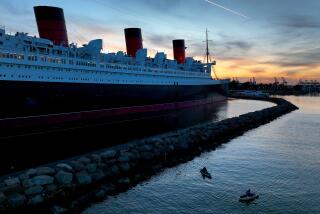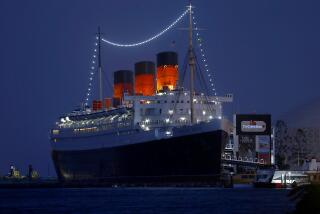‘Good Old Days’--Then and Now : NOW
- Share via
“Back in the good old days. . . .”
How many times have you heard that phrase?
All of us, it seems, use it at one time or another, because time forgives. We forget unhappy experiences, remembering only the happier ones.
Thus the “good old days” of yesteryear possibly might not have been as good as we like to think. That’s especially true of cruising.
Some old-timers speak nostalgically of the time when ocean liners were the only way to cross the Atlantic. It was a marvelous era, no doubt about it, but the finest passenger ships of those so-called “good old days” would pale in comparison to today’s super liners.
Think of what is standard today on the better cruise ships: air conditioning, telephones and television in every cabin, verandas for many staterooms, good entertainment, smoother rides.
The old days were never like that.
I remember sailing across the Atlantic as a child on what was then a state-of-the-art ocean liner, the Conte di Savoia. Caesar himself would have felt at home in its main lounge, a magnificent room two stories high with marble columns and overstuffed divans. But if it was warm and sticky outside, it was warm and sticky inside. On the open decks of the ship were what appeared to be an orchestra of sousaphones, all pointing forward. These bell-shaped devices were air scoops that directed fresh air down in to the ship. An ingenious system, but today’s air conditioning is far better.
On this ship, passengers were divided into classes, and woe be unto you if you wandered out of your class. Tourist-class folks could not be seen on the first-class deck and vice versa.
The class thing went on for years, even as late as 1965, when I sailed across the Atlantic on the maiden voyage of the Italian Line’s Raffaello. That ship had three classes, as did most transatlantic liners then--first, cabin and tourist--and we devoted considerable effort to devising ways to sneak into another class.
Not because we were looking to upgrade ourselves. Quite the opposite. My wife and I were fortunate enough to be traveling first-class, but we soon learned that the tourist-class lounge was much livelier (and younger) than the stuffy one in first-class. We finally got there by using the forbidden crew stairways.
Today, nearly all passenger liner are classless. Only the stately Queen Elizabeth 2 still has passenger categories, with separate dining rooms for each, but somehow this seems all right about the QE2: It is in a class by itself.
Rough weather can make any ship toss, but the new ones have an advantage that the ships of yesteryear never possessed: stabilizers. Years ago, on one of those beloved liners, I remember the ship rolling and plunging in the North Atlantic like a dyspeptic bull. Today’s stabilizers, which are on nearly all cruise ships, soften the movement of the ship and its consequent seasickness.
Shipboard dress used to be much more formal than it is today. On the maiden voyage of the Raffaello, for example, six of our eight nights aboard were formal. When my wife learned this, she sized up every one of our friends and borrowed two formal outfits to go with the four she already possessed. It wouldn’t do, of course, to appear in the same dress twice on the same voyage. For us men, formal nights were simple: we wore the same outfit--a tuxedo--every night.
Formal nights are still a feature of today’s sailings--everybody likes to get dressed up for dinner every now and then--but they are far less frequent. During a one-week cruise, two formal nights usually are decreed--and today that may require nothing dressier than a coat and tie. Some of today’s cruise ships, like the Windstars, which are oriented to water sports, are totally casual. A tie is rarely seen.
On-board facilities have improved dramatically since the “good old days.” Most new ships have gorgeous fitness centers in which passengers can work up a sweat on a variety of exercise machines, then relax in a Jacuzzi or sauna. On the old liners, about the only exercise one could get was walking one’s poodle on a windblown promenade deck, being careful not to stumble over the blanketed octogenarians slumbering in deck chairs.
Since most of today’s ships sail in warm waters, passengers spend a lot of time around the outdoor swimming pools. On the Royal Viking Sun, pool lovers can even swim up to the bar, which has underwater seats. On the ships of old, if one swam at all, it was in a minuscule pool buried in the bowels of the vessel because the North Atlantic weather topside was more foul than fair.
If things have improved so much, why haven’t more old liners been converted to modern cruise ships?
Some tried. Cunard added a pool deck to the Queen Elizabeth I and sent it cruising into the Caribbean, but the regal old lady never hit it off in that role. Permanently moored at a dock in Port Everglades, she became a tourist attraction before being shipped to Hong Kong, where she burned and sank.
The Queen Mary, of course, is tied up to shore in Long Beach, serving as a hotel and tourist attraction. The Raffaello and Michelangelo, the last passenger ships built specifically for the transatlantic trade, were permanently docked in Iran, on the Persian Gulf, for some years, but the Raffaello was bombed and sunk in 1982 during the Iran-Iraq war, and the Michelangelo was brought to Pakistan this summer to be cut up for scrap.
Only the Norway, the former SS France, has converted to full-time cruising and made a go of it (the QE2 still makes transatlantic runs half the year). And it took some doing. One of her engines was removed to make the ship more fuel-efficient. The former indoor pool was converted into a spa. A fitness center, conference room and two decks of cabins with verandas were added. At the same time, the best features of the France were retained. Result: Old-time ambience with up-to-date facilities.
To be sure, not every change that has occurred in the cruise industry is necessarily for the better. Drinks aboard ship used to be almost ridiculously cheap. I can remember paying 35 cents for a martini before the cruise lines began raising drink prices in the 1970s to cover part of the oil price hikes.
Today, drinks provide a healthy percentage of profit for the cruise lines, considering that they still buy their liquor at duty-free prices yet charge almost as much for drinks as shoreside bars do.
On the other hand, shipborne drinks come in much greater variety these days. Could you have ordered a “Strip and Go Naked” drink on the Queen Mary? Of course not, but that concoction and a lot of other “foo-foo” drinks are a feature today aboard the Star Princess and the other “Love Boats” of Princess Cruises.
And while the grand lounges of the old transatlantic liners possessed a great deal of baroque charm, I much prefer the imaginative public rooms and bars on the newer ships.
For sheer atmosphere, no one can outdo architect Joe Farcus, who has designed bars for Carnival Cruise Line with such themes as Egyptian and Moroccan, and in one lounge has patrons sit at tables that resemble grocery-store bins. Crystal Harmony’s Palm Lounge has round skylights and floor-to-ceiling windows. And what a great idea Royal Caribbean Cruise Lines had when it wrapped a combination bar and observation deck around the funnels of its ships!
In one way, the passenger liners of old were better than those of today, and that was at mealtime. It is true that in the 1960s, I once sailed on a British ship whose food was so atrocious that we all looked forward to the Mediterranean port calls, where we could get a good meal ashore. But dining aboard most of the other old vessels was a culinary treat. I remember a sumptuous breakfast aboard the Ile de France that included fresh raspberries and a perfectly cooked filet mignon, and dinners on the Raffaello that elevated pasta and soup to a level I had never before experienced.
By contrast, nearly all of today’s cruise ships serve “hotel-quality” meals--good but not gourmet. Only on one or two ships does the cuisine approach the caliber of the old liners. One of these is the Crystal Harmony, which serves consistently high-caliber food in its main dining room.
Like everything else, the cost of cruising has risen substantially over the years. Twenty years ago you could book a 29-day European cruise on the Sagafjord for $850. Weekend cruises from Miami to the Bahamas cost less than $80. That amount will hardly cover the port charges these days.
Despite this, cruising remains a good and sometimes excellent travel bargain. Cruise fares include ship transportation, accommodations, food and on-board entertainment. They often include air fare to and from one’s embarkation city as well, features that were unheard of in the heyday of the transatlantic liners.
Pine if you will for the ships of old. I’ll take today’s cruise liners any time.
More to Read
Sign up for The Wild
We’ll help you find the best places to hike, bike and run, as well as the perfect silent spots for meditation and yoga.
You may occasionally receive promotional content from the Los Angeles Times.






